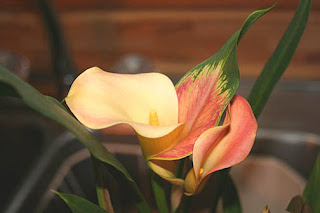
The great Canadian writer and thinker Margaret Atwood remarked that "In the spring, at the end of the day, you should smell like dirt." I’m happy to declare that when I finally slouched my aching bones into the house, I smelled of dirt, sweat, Naturally Nancy’s protective cream, and probably a bit of residual sunscreen. I was also intensely tired but happy.
Every now and again, we have to declare a mental health day. Given events of earlier in the week, and that I have to go away tomorrow to give a talk, today seemed like a good day to do that. As soon as I could, I was outside ready to grub in the dirt. My dearly beloved arrived home with the Tacoma’s box filled with bags of lovely, rich, fragrant mushroom compost from the organic mushroom growers down the Valley. He then proceeded to put a couple near each garden bed for me so that I wouldn’t have to wrestle with them myself. I sort of overdid it yesterday, digging in the manure heap for the well decomposed black muck that the gardens love, then digging up things, moving stuff, hauling around piles of dirt and manure and weeds.
Two days of warmth and the gardens have shaken themselves off and remembered what they’re meant to do. I could almost HEAR things growing; the unfurling leaves of the horse chestnut report that we will have at least 9 blossoms on that dear young tree this year . The mayapples have poked their alien looking noses up out of the soil and in another day will be opening their umbrella like leaves.

Which reminds me—I will need to take the axe and the hacksaw to the Darmera peltata, because it desperately needs dividing and is lurching up out of the soil, its thick rhizomes like elephants trunks. I’ll save that for Sunday, perhaps.
Mungus was my able assistant this afternoon, fussing to go out until I relented and put his harness on him. He’s perfectly happen on the harness so long as he can see me—if I get out of his sight, he sits and cries tragically. He contented himself with digging those giant feet in fresh soil, rolling upside down in the grass, and laying flat pretending to be a tiger stalking the hummingbirds. They were too busy arguing over the feeders and the flowers to pay him any mind, supremely confident in their dazzling speed.
I’m not a fan of some common annuals—I like them in other gardens but don’t want them in mine. Impatiens are a case in point—except for New Guinea impatiens, particularly this delicate yellow darling. It and its sister are going into the shade garden where they’ll look quite lovely, I think.

The next photo is a bit of a monumental task, half accomplished already though. This bed was badly weedy with those blasted creeping bluebells (Campanula rapunculoides) and finally I decided the only thing for it was to dig things up, remove the bluebells, and replant.

In the progress, I’m also raising the bed about six inches where I don’t have plants that need digging up. First a layer of newspapers, then the old wet hay we used to bank the house through the winter; follow that with a generous helping of well rotted horse manure, and top that off with a couple of inches of soil. I can plant shallow-rooted perennials into it now—well, in a week after some rain and settling—and come fall, it’ll be ready for bulbs too. But it’s slow work and my old aching muscles are well and truly tired! But happy. Long Suffering Spouse doesn’t do bed building/raising although he’d shovel piles of manure for me if I asked. But I can do it. My experience with hiring someone to help turned out rather less happily than I had expected, so whatever I can do is what will get done. He can edge the beds that need edging and I’ll be thrilled with that.

Mungus and I did some moving of plants this evening; I tucked in the tree peony, the Coppertina Ninebark, and the Lime Glow juniper, plus some perennials. I scored a Harvest Moon Echinacea this afternoon over town while in search of annuals for my talk tomorrow, so that will go in with Jade, Green Envy, and another Sunset Echinacea. It would be lovely if they’d all flower at the same time, wouldn’t it? Now I just need a white one again—I find them less hardy than the standard purple coneflowers, but the new Big Sky plants have come back just fine for me.

This little bed has a lot of plants in it, and while most of them are still young, they put on a great show. Stars include Cimicifuga ‘Black Negligee’, Bromus ‘Skinner’s Gold’, Geranium ‘Hocus Pocus’, a variety of pulmonaria, some fall flowering asters, ‘David’ phlox, and ‘El Desperado’ daylily. But there are also blue star (Amsonia), several euphorbia, some pinks of various shapes, a couple of bellflowers, and I expect Raspberry Wine Monarda to put on a great show this summer.
And just a little while ago, we were treated to the first celestial pyrotechnic display of the season. A nice little thundershow, mostly lightning, mostly a few miles off, not enough rain to wash the birdseed off the deck where Long Suffering Spouse spilled it earlier. It’s been a good day. Tomorrow, I wonder what we'll bring home in the trunk? There are always new plants to find....






















































